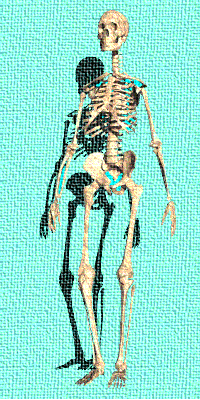 Primer |
The Human SkeletonThe skeleton is the armature and the understructure which defines the human body. Leonardo da Vinci realized the importance of the skeleton which he sketched over and over. The Skeletal Structure: One can use elements from the underlying structure of the body to draw more proportionate figures. The best way to use the skeleton is to first draw the skeleton from different views. Then look for places where the skeleton is evident when drawing the figure.
Follow this link for a good example of a skull drawing from Leonardo da Vinci.
Questions or comments can be forwarded to Ralph Larmann at the University of Evansville. | 
This page is provided as an alternative page for those who don't have Java-enhanced browsers or want to speed up download time. The animation above shows the human skeleton from 16 different angles. It will revolve three times, then stop.  
|

| [Primer] created 6/15/98 by R. M. Larmann |

Custom Search
|